Transformer and Attention-Based Architectures for Segmentation of Coronary Arterial Walls in Intravascular Ultrasound: A Narrative Review
Abstract
:1. Introduction
2. Search Strategy and Statistical Distributions
2.1. Statistical Distributions
2.1.1. Publication Trend in IVUS Wall Segmentation
2.1.2. Publication Trend of Transformers in IVUS Segmentation
2.1.3. Distribution of Type of Transformers
2.1.4. Distribution by Publishers
2.1.5. Distribution of Evaluation Metrics
3. Classification of IVUS Segmentation Architectures
3.1. Conventional Methods
3.1.1. Thresholding
3.1.2. Active Contours
3.2. Machine Learning Techniques
3.2.1. Markov Random Field
3.2.2. Random Forest
3.3. Deep Learning Techniques
3.3.1. Non-UNet Paradigms
Scale Mutualized Perception
Combining Shallow and Deep Networks
3.3.2. UNet Paradigms and Its Variants
MFA-UNet
IVUS-UNet++
3.4. Attention and Transformer Methods
3.4.1. Perceptual Organisation-Aware Selective Transformer Framework
3.4.2. Multilevel Structure-Preserved Generative Adversarial Network (MSP-GAN)
4. Critical Discussion
4.1. Principal Findings
4.2. Benchmarking
4.3. A Special Note on Transformers in Coronary Artery Segmentation
4.4. A Special Note on Clinical Relevance and Integration of Transformer-Based IVUS Segmentation into Clinical Practice
4.5. Strengths: Technological Advancements and Integration
4.6. Weaknesses: Limitations in Data, Generalization, and Practicality
4.7. Extensions: Future Research and Clinical Implementation
5. Conclusions
Author Contributions
Funding
Institutional Review Board Statement
Informed Consent Statement
Data Availability Statement
Acknowledgments
Conflicts of Interest
Table for Acronyms (SN: Serial Number; Abbn: Abbreviations)
| SN | Abbn | Description | SN | Abbn | Description |
| 1 | ACS | Acute Coronary Syndrome | 43 | MCC | Matthews Correlation Coefficient |
| 2 | CAD | Coronary Artery Disease | 44 | AUC | Area Under the Curve |
| 3 | CVD | Cardiovascular Disease | 45 | ROC | Receiver Operating Characteristic |
| 4 | CT | Computed Tomography | 46 | PR | Precision-Recall |
| 5 | DL | Deep Learning | 47 | FPS | Frames Per Second |
| 6 | IVUS | Intravascular Ultrasound | 48 | GPU | Graphics Processing Unit |
| 7 | LI | Lumen-Intima | 49 | CPU | Central Processing Unit |
| 8 | MA | Media-Adventitia | 50 | mAP | Mean Average Precision |
| 9 | MRI | Magnetic Resonance Imaging | 51 | PA | Pixel Accuracy |
| 10 | OCT | Optical Coherence Tomography | 52 | mIoU | Mean Intersection over Union |
| 11 | PRISMA | Preferred Reporting Items for Systematic Reviews and Meta-Analyses | 53 | FWIoU | Frequency Weighted Intersection over Union |
| 12 | SDL | Solo Deep Learning | 54 | TP | True Positive |
| 13 | HDL | Hybrid Deep Learning | 55 | TN | True Negative |
| 14 | CNN | Convolutional Neural Network | 56 | FP | False Positive |
| 15 | CRF | Conditional Random Field | 57 | FN | False Negative |
| 16 | FAM | Feature Aggregation Module | 58 | PPV | Positive Predictive Value |
| 17 | BConvLSTM | Bi-directional Convolutional Long Short-Term Memory | 59 | NPV | Negative Predictive Value |
| 18 | MFAUNet | Multi-scale Feature Aggregated UNet | 60 | FDR | False Discovery Rate |
| 19 | UNet++ | UNet Plus Plus | 61 | FOR | False Omission Rate |
| 20 | IoU | Intersection over Union | 62 | MSE | Mean Squared Error |
| 21 | JM | Jaccard Measure | 63 | RMSE | Root Mean Squared Error |
| 22 | HD | Hausdorff Distance | 64 | MAE | Mean Absolute Error |
| 23 | GAN | Generative Adversarial Network | 65 | RAE | Relative Absolute Error |
| 24 | MSP-GAN | Multilevel Structure-Preserved Generative Adversarial Network | 66 | RSE | Relative Squared Error |
| 25 | SMC | Super pixel-wise Multi-scale Contrastive Constraint | 67 | R2 | Coefficient of Determination |
| 26 | TF | Temporal Constraining and Fusion | 68 | Adj. R2 | Adjusted R-squared |
| 27 | STR UNet | Selective Transformer Recurrent UNet | 69 | AIC | Akaike Information Criterion |
| 28 | MIC | Maximum Intensity Curve | 70 | BIC | Bayesian Information Criterion |
| 29 | RMM | Rayleigh Mixture Model | 71 | LOO-CV | Leave-One-Out Cross-Validation |
| 30 | MRF | Markov Random Field | 72 | K-fold CV | K-fold Cross-Validation |
| 31 | FCM | Fuzzy C-Means | 73 | Lasso | Least Absolute Shrinkage and Selection Operator |
| 32 | HMRF | Hidden Markov Random Field | 74 | Ridge | Ridge Regression |
| 33 | SVM | Support Vector Machine | 75 | Elastic Net | Elastic Net Regression |
| 34 | RF | Random Forest | 76 | PCA | Principal Component Analysis |
| 35 | FODPSO | Fractional-order Darwinian Particle Swarm Optimization | 77 | t-SNE | t-Distributed Stochastic Neighbor Embedding |
| 36 | PAD | Percentage of Area Difference | 78 | UMAP | Uniform Manifold Approximation and Projection |
| 37 | HSD | Hausdorff Surface Distance | 79 | NMF | Non-negative Matrix Factorization |
| 38 | Dice | Dice Coefficient | 80 | ICA | Independent Component Analysis |
| 39 | Precision | Precision Score | 81 | SVD | Singular Value Decomposition |
| 40 | Recall | Recall Score | 82 | LLE | Locally Linear Embedding |
| 41 | F1 | F1 Score | 83 | ISOMAP | Isometric Mapping |
| 42 | Kappa | Cohen’s Kappa Score | 84 | MDS | Multidimensional Scaling |
References
- Saba, L.; Maindarkar, M.; Khanna, N.N.; Johri, A.M.; Mantella, L.; Laird, J.R.; Paraskevas, K.I.; Ruzsa, Z.; Kalra, M.K.; Fernandes, J.F.E. A Pharmaceutical Paradigm for Cardiovascular Composite Risk Assessment Using Novel Radiogenomics Risk Predictors in Precision Explainable Artificial Intelligence Framework: Clinical Trial Tool. Front. Biosci.-Landmark 2023, 28, 248. [Google Scholar] [CrossRef] [PubMed]
- Gaidai, O.; Xing, Y.; Balakrishna, R.; Sun, J.; Bai, X. Prediction of death rates for cardiovascular diseases and cancers. Cancer Innov. 2023, 2, 140–147. [Google Scholar] [PubMed]
- Vähätalo, J.; Holmström, L.; Pakanen, L.; Kaikkonen, K.; Perkiömäki, J.; Huikuri, H.; Junttila, J. Coronary artery disease as the cause of sudden cardiac death among victims < 50 years of age. Am. J. Cardiol. 2021, 147, 33–38. [Google Scholar]
- Saba, L.; Maindarkar, M.; Johri, A.M.; Mantella, L.; Laird, J.R.; Khanna, N.N.; Paraskevas, K.I.; Ruzsa, Z.; Kalra, M.K.; Fernandes, J.F.E. UltraAIGenomics: Artificial Intelligence-Based Cardiovascular Disease Risk Assessment by Fusion of Ultrasound-Based Radiomics and Genomics Features for Preventive, Personalized and Precision Medicine: A Narrative Review. Rev. Cardiovasc. Med. 2024, 25, 184. [Google Scholar] [PubMed]
- Khanna, N.N.; Maindarkar, M.; Puvvula, A.; Paul, S.; Bhagawati, M.; Ahluwalia, P.; Ruzsa, Z.; Sharma, A.; Munjral, S.; Kolluri, R. Vascular implications of COVID-19: Role of radiological imaging, artificial intelligence, and tissue characterization: A special report. J. Cardiovasc. Dev. Dis. 2022, 9, 268. [Google Scholar] [CrossRef]
- Kandaswamy, E.; Zuo, L. Recent advances in treatment of coronary artery disease: Role of science and technology. Int. J. Mol. Sci. 2018, 19, 424. [Google Scholar] [CrossRef]
- Suri, J.S.; Kathuria, C.; Molinari, F. Atherosclerosis Disease Management; Springer Science & Business Media: Berlin/Heidelberg, Germany, 2010. [Google Scholar]
- Gharleghi, R.; Chen, N.; Sowmya, A.; Beier, S. Towards automated coronary artery segmentation: A systematic review. Comput. Methods Programs Biomed. 2022, 225, 107015. [Google Scholar] [CrossRef]
- Khanna, N.N.; Maindarkar, M.; Saxena, A.; Ahluwalia, P.; Paul, S.; Srivastava, S.K.; Cuadrado-Godia, E.; Sharma, A.; Omerzu, T.; Saba, L. Cardiovascular/stroke risk assessment in patients with erectile dysfunction—A role of carotid wall arterial imaging and plaque tissue characterization using artificial intelligence paradigm: A narrative review. Diagnostics 2022, 12, 1249. [Google Scholar] [CrossRef]
- Khanna, N.N.; Singh, M.; Maindarkar, M.; Kumar, A.; Johri, A.M.; Mentella, L.; Laird, J.R.; Paraskevas, K.I.; Ruzsa, Z.; Singh, N. Polygenic Risk Score for Cardiovascular Diseases in Artificial Intelligence Paradigm: A Review. J. Korean Med. Sci. 2023, 38, e395. [Google Scholar]
- Garcìa-Garcìa, H.M.; Gogas, B.D.; Serruys, P.W.; Bruining, N. IVUS-based imaging modalities for tissue characterization: Similarities and differences. Int. J. Cardiovasc. Imaging 2011, 27, 215–224. [Google Scholar]
- Katouzian, A.; Angelini, E.D.; Carlier, S.G.; Suri, J.S.; Navab, N.; Laine, A.F. A state-of-the-art review on segmentation algorithms in intravascular ultrasound (IVUS) images. IEEE Trans. Inf. Technol. Biomed. 2012, 16, 823–834. [Google Scholar] [CrossRef] [PubMed]
- Ma, T.; Yu, M.; Chen, Z.; Fei, C.; Shung, K.K.; Zhou, Q. Multi-frequency intravascular ultrasound (IVUS) imaging. IEEE Trans. Ultrason. Ferroelectr. Freq. Control. 2015, 62, 97–107. [Google Scholar] [CrossRef] [PubMed]
- Boi, A.; Jamthikar, A.D.; Saba, L.; Gupta, D.; Sharma, A.; Loi, B.; Laird, J.R.; Khanna, N.N.; Suri, J.S. A survey on coronary atherosclerotic plaque tissue characterization in intravascular optical coherence tomography. Curr. Atheroscler. Rep. 2018, 20, 33. [Google Scholar] [CrossRef] [PubMed]
- Sinclair, H.; Bourantas, C.; Bagnall, A.; Mintz, G.S.; Kunadian, V. OCT for the identification of vulnerable plaque in acute coronary syndrome. JACC Cardiovasc. Imaging 2015, 8, 198–209. [Google Scholar] [CrossRef]
- Marano, R.; Rovere, G.; Savino, G.; Flammia, F.C.; Carafa, M.R.P.; Steri, L.; Merlino, B.; Natale, L. CCTA in the diagnosis of coronary artery disease. La Radiol. Medica 2020, 125, 1102–1113. [Google Scholar] [CrossRef]
- Gao, Y.; Zhou, M.; Metaxas, D.N. UTNet: A hybrid transformer architecture for medical image segmentation. In Medical Image Computing and Computer Assisted Intervention—MICCAI 2021, Proceedings of the 24th International Conference, Strasbourg, France, 27 September–1 October 2021, Proceedings, Part III 24; Springer: Berlin/Heidelberg, Germany, 2021. [Google Scholar]
- Al-Maini, M.; Maindarkar, M.; Kitas, G.D.; Khanna, N.N.; Misra, D.P.; Johri, A.M.; Mantella, L.; Agarwal, V.; Sharma, A.; Singh, I.M. Artificial intelligence-based preventive, personalized and precision medicine for cardiovascular disease/stroke risk assessment in rheumatoid arthritis patients: A narrative review. Rheumatol. Int. 2023, 43, 1965–1982. [Google Scholar] [CrossRef]
- Suri, J.S.; Paul, S.; Maindarkar, M.A.; Puvvula, A.; Saxena, S.; Saba, L.; Turk, M.; Laird, J.R.; Khanna, N.N.; Viskovic, K. Cardiovascular/stroke risk stratification in Parkinson’s disease patients using atherosclerosis pathway and artificial intelligence paradigm: A systematic review. Metabolites 2022, 12, 312. [Google Scholar] [CrossRef]
- Khanna, N.N.; Maindarkar, M.A.; Viswanathan, V.; Puvvula, A.; Paul, S.; Bhagawati, M.; Ahluwalia, P.; Ruzsa, Z.; Sharma, A.; Kolluri, R. Cardiovascular/Stroke Risk Stratification in Diabetic Foot Infection Patients Using Deep Learning-Based Artificial Intelligence: An Investigative Study. J. Clin. Med. 2022, 11, 6844. [Google Scholar] [CrossRef]
- Bourantas, C.V.; Garg, S.; Naka, K.K.; Thury, A.; Hoye, A.; Michalis, L.K. Focus on the research utility of intravascular ultrasound-comparison with other invasive modalities. Cardiovasc. Ultrasound 2011, 9, 2. [Google Scholar] [CrossRef]
- Araki, T.; Ikeda, N.; Shukla, D.; Londhe, N.D.; Shrivastava, V.K.; Banchhor, S.K.; Saba, L.; Nicolaides, A.; Shafique, S.; Laird, J.R. A new method for IVUS-based coronary artery disease risk stratification: A link between coronary & carotid ultrasound plaque burdens. Comput. Methods Programs Biomed. 2016, 124, 161–179. [Google Scholar]
- Banchhor, S.K.; Araki, T.; Londhe, N.D.; Ikeda, N.; Radeva, P.; Elbaz, A.; Saba, L.; Nicolaides, A.; Shafique, S.; Laird, J.R. Five multiresolution-based calcium volume measurement techniques from coronary IVUS videos: A comparative approach. J. Comput. Methods Programs Biomed. 2016, 134, 237–258. [Google Scholar]
- Sonoda, S.; Hibi, K.; Okura, H.; Fujii, K.; Node, K.; Kobayashi, Y.; Honye, J. Current clinical use of intravascular ultrasound imaging to guide percutaneous coronary interventions (update). Cardiovasc. Interv. Ther. 2023, 38, 1–7. [Google Scholar] [PubMed]
- Biswas, M.; Kuppili, V.; Saba, L.; Edla, D.R.; Suri, H.S.; Sharma, A.; Cuadrado-Godia, E.; Laird, J.R.; Nicolaides, A.; Suri, J.S. A deep-learning fully convolutional network for lumen characterization in diabetic patients using carotid ultrasound: A tool for stroke risk. In Vascular and Intravascular Imaging Trends, Analysis, and Challenges, Volume 2: Plaque Characterization; IOP Publishing: Bristol, UK, 2019; pp. 5-1–5-33. [Google Scholar]
- Jain, P.K.; Sharma, N.; Kalra, M.K.; Johri, A.; Saba, L.; Suri, J.S. Far wall plaque segmentation and area measurement in common and internal carotid artery ultrasound using U-series architectures: An unseen Artificial Intelligence paradigm for stroke risk assessment. Comput. Biol. Med. 2022, 149, 106017. [Google Scholar]
- Jain, P.K.; Dubey, A.; Saba, L.; Khanna, N.N.; Laird, J.R.; Nicolaides, A.; Fouda, M.M.; Suri, J.S.; Sharma, N. Attention-based UNet Deep Learning model for Plaque segmentation in carotid ultrasound for stroke risk stratification: An artificial Intelligence paradigm. J. Cardiovasc. Dev. Dis. 2022, 9, 326. [Google Scholar] [CrossRef]
- Biswas, M.; Saba, L.; Kalra, M.; Singh, R.; e Fernandes, J.F.; Viswanathan, V.; Laird, J.R.; Mantella, L.E.; Johri, A.M.; Fouda, M.M. MultiNet 2.0: A Lightweight Attention-based Deep Learning Network for Stenosis measurement in Carotid Ultrasound scans and Cardiovascular Risk Assessment. Comput. Med. Imaging Graph. 2024, 117, 102437. [Google Scholar]
- Chen, R.J.; Wang, J.J.; Williamson, D.F.; Chen, T.Y.; Lipkova, J.; Lu, M.Y.; Sahai, S.; Mahmood, F. Algorithmic fairness in artificial intelligence for medicine and healthcare. Nat. Biomed. Eng. 2023, 7, 719–742. [Google Scholar] [CrossRef]
- Zhu, F.; Gao, Z.; Zhao, C.; Zhu, H.; Nan, J.; Tian, Y.; Dong, Y.; Jiang, J.; Feng, X.; Dai, N. A deep learning-based method to extract lumen and media-adventitia in intravascular ultrasound images. Ultrason. Imaging 2022, 44, 191–203. [Google Scholar]
- Kumari, V.; Kumar, N.; Kumar, K.S.; Kumar, A.; Skandha, S.S.; Saxena, S.; Khanna, N.N.; Laird, J.R.; Singh, N.; Fouda, M.M. Deep Learning Paradigm and Its Bias for Coronary Artery Wall Segmentation in Intravascular Ultrasound Scans: A Closer Look. J. Cardiovasc. Dev. Dis. 2023, 10, 485. [Google Scholar] [CrossRef]
- Shen, D.; Wu, G.; Suk, H.-I. Deep learning in medical image analysis. Annu. Rev. Biomed. Eng. 2017, 19, 221–248. [Google Scholar]
- Wang, Y.; Yao, Y. Application of artificial intelligence methods in carotid artery segmentation: A review. IEEE Access 2023, 11, 13846–13858. [Google Scholar]
- Tian, F.; Gao, Y.; Fang, Z.; Gu, J. Automatic coronary artery segmentation algorithm based on deep learning and digital image processing. Appl. Intell. 2021, 51, 8881–8895. [Google Scholar]
- El-Baz, A.; Suri, J.S. Big Data in Multimodal Medical Imaging; CRC Press: Boca Raton, FL, USA, 2019. [Google Scholar]
- El-Baz, A.S.; Suri, J.S. Cardiovascular and Coronary Artery Imaging: Volume 1; Academic Press: Cambridge, MA, USA, 2021. [Google Scholar]
- Yang, S.; Kweon, J.; Roh, J.-H.; Lee, J.-H.; Kang, H.; Park, L.-J.; Kim, D.J.; Yang, H.; Hur, J.; Kang, D.-Y. Deep learning segmentation of major vessels in X-ray coronary angiography. Sci. Rep. 2019, 9, 16897. [Google Scholar]
- Biswas, M.; Saba, L.; Chakrabartty, S.; Khanna, N.N.; Song, H.; Suri, H.S.; Sfikakis, P.P.; Mavrogeni, S.; Viskovic, K.; Laird, J.R. Two-stage artificial intelligence model for jointly measurement of atherosclerotic wall thickness and plaque burden in carotid ultrasound: A screening tool for cardiovascular/stroke risk assessment. J. Comput. Biol. 2020, 123, 103847. [Google Scholar]
- Huang, C.; Wang, J.; Xie, Q.; Zhang, Y.-D. Analysis methods of coronary artery intravascular images: A review. Neurocomputing 2022, 489, 27–39. [Google Scholar]
- Jena, B.; Saxena, S.; Nayak, G.K.; Saba, L.; Sharma, N.; Suri, J.S. Artificial intelligence-based hybrid deep learning models for image classification: The first narrative review. Comput. Biol. Med. 2021, 137, 104803. [Google Scholar]
- Sanagala, S.S.; Nicolaides, A.; Gupta, S.K.; Koppula, V.K.; Saba, L.; Agarwal, S.; Johri, A.M.; Kalra, M.S.; Suri, J.S. Ten Fast Transfer Learning Models for Carotid Ultrasound Plaque Tissue Characterization in Augmentation Framework Embedded with Heatmaps for Stroke Risk Stratification. J. Diagn. 2021, 11, 2109. [Google Scholar]
- Skandha, S.S.; Nicolaides, A.; Gupta, S.K.; Koppula, V.K.; Saba, L.; Johri, A.M.; Kalra, M.S.; Suri, J.S. A hybrid deep learning paradigm for carotid plaque tissue characterization and its validation in multicenter cohorts using a supercomputer framework. J. Comput. Biol. Med. 2022, 141, 105131. [Google Scholar]
- Liu, F.; Lin, G.; Shen, C. CRF learning with CNN features for image segmentation. Pattern Recognit. 2015, 48, 2983–2992. [Google Scholar]
- Jain, P.K.; Sharma, N.; Giannopoulos, A.A.; Saba, L.; Nicolaides, A.; Suri, J.S. Hybrid deep learning segmentation models for atherosclerotic plaque in internal carotid artery B-mode ultrasound. Comput. Biol. Med. 2021, 136, 104721. [Google Scholar]
- Shamshad, F.; Khan, S.; Zamir, S.W.; Khan, M.H.; Hayat, M.; Khan, F.S.; Fu, H. Transformers in medical imaging: A survey. Med. Image Anal. 2023, 88, 102802. [Google Scholar]
- He, K.; Gan, C.; Li, Z.; Rekik, I.; Yin, Z.; Ji, W.; Gao, Y.; Wang, Q.; Zhang, J.; Shen, D. Transformers in medical image analysis. Intell. Med. 2023, 3, 59–78. [Google Scholar] [CrossRef]
- Strudel, R.; Garcia, R.; Laptev, I.; Schmid, C. Segmenter: Transformer for semantic segmentation. In Proceedings of the IEEE/CVF International Conference on Computer Vision, Virtual, 11–17 October 2021. [Google Scholar]
- Arora, P.; Singh, P.; Girdhar, A.; Vijayvergiya, R.; Chaudhary, P. CADNet: An advanced architecture for automatic detection of coronary artery calcification and shadow border in intravascular ultrasound (IVUS) images. Phys. Eng. Sci. Med. 2023, 46, 773–786. [Google Scholar] [CrossRef] [PubMed]
- Huang, X.; Bajaj, R.; Li, Y.; Ye, X.; Lin, J.; Pugliese, F.; Ramasamy, A.; Gu, Y.; Wang, Y.; Torii, R. POST-IVUS: A perceptual organisation-aware selective transformer framework for intravascular ultrasound segmentation. Med. Image Anal. 2023, 89, 102922. [Google Scholar] [CrossRef]
- Liu, Y.; Nezami, F.R.; Edelman, E.R. A Transformer-based pyramid network for coronary calcified plaque segmentation in intravascular optical coherence tomography images. Comput. Med. Imaging Graph. 2024, 113, 102347. [Google Scholar] [CrossRef]
- Tao, X.; Dang, H.; Zhou, X.; Xu, X.; Xiong, D. Automated segmentation of lumen and media-adventitia in intravascular ultrasound images based on deep learning. In Proceedings of the 2023 3rd International Conference on Consumer Electronics and Computer Engineering (ICCECE), Guangzhou, China, 6–8 January 2023; IEEE: New York, NY, USA, 2023. [Google Scholar]
- Xia, M.; Yang, H.; Qu, Y.; Guo, Y.; Zhou, G.; Zhang, F.; Wang, Y. Multilevel structure-preserved GAN for domain adaptation in intravascular ultrasound analysis. Med. Image Anal. 2022, 82, 102614. [Google Scholar] [CrossRef]
- Zhang, L.; Chen, Z.; Zhang, H.; Zaman, F.A.; Wahle, A.; Wu, X.; Sonka, M. Efficient Deep-Learning-Assisted Annotation for Medical Image Segmentation. Authorea Prepr. 2023. [Google Scholar] [CrossRef]
- Zhi, Y.; Zhang, H.; Gao, Z. Vessel contour detection in intracoronary images via bilateral cross-domain adaptation. IEEE J. Biomed. Health Inform. 2023, 27, 3314–3325. [Google Scholar] [CrossRef]
- Dosovitskiy, A.; Beyer, L.; Kolesnikov, A.; Weissenborn, D.; Zhai, X.; Unterthiner, T.; Dehghani, M.; Minderer, M.; Heigold, G.; Gelly, S. An image is worth 16x16 words: Transformers for image recognition at scale. arXiv 2020, arXiv:2010.11929. [Google Scholar]
- Giannoglou, G.D.; Chatzizisis, Y.S.; Koutkias, V.; Kompatsiaris, I.; Papadogiorgaki, M.; Mezaris, V.; Parissi, E.; Diamantopoulos, P.; Strintzis, M.G.; Maglaveras, N. A novel active contour model for fully automated segmentation of intravascular ultrasound images: In vivo validation in human coronary arteries. Comput. Biol. Med. 2007, 37, 1292–1302. [Google Scholar] [CrossRef]
- Destrempes, F.; Cardinal, M.-H.R.; Allard, L.; Tardif, J.-C.; Cloutier, G. Segmentation method of intravascular ultrasound images of human coronary arteries. Comput. Med. Imaging Graph. 2014, 38, 91–103. [Google Scholar] [CrossRef]
- Hammouche, A.; Cloutier, G.; Tardif, J.-C.; Hammouche, K.; Meunier, J. Automatic IVUS lumen segmentation using a 3D adaptive helix model. Comput. Biol. Med. 2019, 107, 58–72. [Google Scholar] [PubMed]
- Huang, Y.; Yan, W.; Xia, M.; Guo, Y.; Zhou, G.; Wang, Y. Vessel membrane segmentation and calcification location in intravascular ultrasound images using a region detector and an effective selection strategy. Comput. Methods Programs Biomed. 2020, 189, 105339. [Google Scholar] [CrossRef] [PubMed]
- Kermani, A.; Ayatollahi, A. A new nonparametric statistical approach to detect lumen and Media-Adventitia borders in intravascular ultrasound frames. Comput. Biol. Med. 2018, 104, 10–28. [Google Scholar] [PubMed]
- Vercio, L.L.; Del Fresno, M.; Larrabide, I. Lumen-intima and media-adventitia segmentation in IVUS images using supervised classifications of arterial layers and morphological structures. Comput. Methods Programs Biomed. 2019, 177, 113–121. [Google Scholar] [CrossRef]
- Bajaj, R.; Huang, X.; Kilic, Y.; Ramasamy, A.; Jain, A.; Ozkor, M.; Tufaro, V.; Safi, H.; Erdogan, E.; Serruys, P.W. Advanced deep learning methodology for accurate, real-time segmentation of high-resolution intravascular ultrasound images. Int. J. Cardiol. 2021, 339, 185–191. [Google Scholar] [CrossRef]
- Nishi, T.; Yamashita, R.; Imura, S.; Tateishi, K.; Kitahara, H.; Kobayashi, Y.; Yock, P.G.; Fitzgerald, P.J.; Honda, Y. Deep learning-based intravascular ultrasound segmentation for the assessment of coronary artery disease. Int. J. Cardiol. 2021, 333, 55–59. [Google Scholar] [CrossRef]
- Balaji, A.; Kelsey, L.J.; Majeed, K.; Schultz, C.J.; Doyle, B.J. Coronary artery segmentation from intravascular optical coherence tomography using deep capsules. Artif. Intell. Med. 2021, 116, 102072. [Google Scholar]
- Meng, L.; Jiang, M.; Zhang, C.; Zhang, J. Deep learning segmentation, classification, and risk prediction of complex vascular lesions on intravascular ultrasound images. Biomed. Signal Process. Control 2023, 82, 104584. [Google Scholar] [CrossRef]
- Sun, S.; Sonka, M.; Beichel, R.R. Graph-based IVUS segmentation with efficient computer-aided refinement. IEEE Trans. Med. Imaging 2013, 32, 1536–1549. [Google Scholar]
- Jodas, D.S.; Pereira, A.S.; Tavares, J.M.R. Automatic segmentation of the lumen region in intravascular images of the coronary artery. Med. Image Anal. 2017, 40, 60–79. [Google Scholar]
- Onpans, J.; Yookwan, W.; Sangrueng, J.; Srikamdee, S. Intravascular Ultrasound Image Composite Segmentation using Ensemble Gabor-spatial Features. In Proceedings of the 2022 13th International Conference on Information and Communication Technology Convergence (ICTC), Jeju Island, Republic of Korea, 19–21 October 2022; IEEE: New York, NY, USA, 2022. [Google Scholar]
- Liu, X.; Feng, T.; Liu, W.; Song, L.; Yuan, Y.; Hau, W.K.; Del Ser, J.; Gao, Z. Scale mutualized perception for vessel border detection in intravascular ultrasound images. IEEE/ACM Trans. Comput. Biol. Bioinform. 2024, 21, 1060–1071. [Google Scholar] [PubMed]
- Mendizabal-Ruiz, E.G.; Rivera, M.; Kakadiaris, I.A. Segmentation of the luminal border in intravascular ultrasound B-mode images using a probabilistic approach. Med. Image Anal. 2013, 17, 649–670. [Google Scholar] [CrossRef] [PubMed]
- Gao, Z.; Chung, J.; Abdelrazek, M.; Leung, S.; Hau, W.K.; Xian, Z.; Zhang, H.; Li, S. Privileged modality distillation for vessel border detection in intracoronary imaging. IEEE Trans. Med. Imaging 2019, 39, 1524–1534. [Google Scholar]
- Mishra, D.; Chaudhury, S.; Sarkar, M.; Soin, A.S. Ultrasound image segmentation: A deeply supervised network with attention to boundaries. IEEE Trans. Biomed. Eng. 2018, 66, 1637–1648. [Google Scholar]
- Yuan, S.; Yang, F. CSDN: Combining Shallow and Deep Networks for Accurate Real-Time Segmentation of High-Definition Intravascular Ultrasound Images. In Proceedings of the 2023 IEEE 20th International Symposium on Biomedical Imaging (ISBI), Cartagena, Colombia, 18–21 April 2023; IEEE: New York, NY, USA, 2023. [Google Scholar]
- Li, Y.-C.; Shen, T.-Y.; Chen, C.-C.; Chang, W.-T.; Lee, P.-Y.; Huang, C.-C.J. Automatic detection of atherosclerotic plaque and calcification from intravascular ultrasound images by using deep convolutional neural networks. IEEE Trans. Ultrason. Ferroelectr. Freq. Control 2021, 68, 1762–1772. [Google Scholar]
- Xia, M.; Yan, W.; Huang, Y.; Guo, Y.; Zhou, G.; Wang, Y. Extracting membrane borders in ivus images using a multi-scale feature aggregated u-net. In Proceedings of the 2020 42nd Annual International Conference of the IEEE Engineering in Medicine & Biology Society (EMBC), Montreal, QC, Canada, 20–24 July 2020; IEEE: New York, NY, USA, 2020. [Google Scholar]
- Serrano-Antón, B.; Otero-Cacho, A.; López-Otero, D.; Díaz-Fernández, B.; Bastos-Fernández, M.; Pérez-Muñuzuri, V.; González-Juanatey, J.R.; Muñuzuri, A.P. Coronary artery segmentation based on transfer learning and UNet architecture on computed tomography coronary angiography images. IEEE Access 2023, 11, 75484–75496. [Google Scholar]
- Araki, T.; Banchhor, S.K.; Londhe, N.D.; Ikeda, N.; Radeva, P.; Shukla, D.; Saba, L.; Balestrieri, A.; Nicolaides, A.; Shafique, S. Reliable and accurate calcium volume measurement in coronary artery using intravascular ultrasound videos. J. Med. Syst. 2016, 40, 51. [Google Scholar]
- Bargsten, L.; Raschka, S.; Schlaefer, A. Capsule networks for segmentation of small intravascular ultrasound image datasets. Int. J. Comput. Assist. Radiol. Surg. 2021, 16, 1243–1254. [Google Scholar]
- Yang, J.; Tong, L.; Faraji, M.; Basu, A. IVUS-Net: An intravascular ultrasound segmentation network. In Proceedings of the Smart Multimedia: First International Conference, ICSM 2018, Toulon, France, 24–26 August 2018, Revised Selected Papers 1; Springer: Berlin/Heidelberg, Germany, 2018. [Google Scholar]
- Chen, T.; Yu, H.; Jia, H.; Dai, J.; Fang, C.; Ma, L.; Liu, H.; Xu, M.; Yu, B. Automatic assessment of calcified plaque and nodule by optical coherence tomography adopting deep learning model. Int. J. Cardiovasc. Imaging 2022, 38, 2501–2510. [Google Scholar]
- Arora, P.; Singh, P.; Girdhar, A.; Vijayvergiya, R. A state-of-the-art review on coronary artery border segmentation algorithms for intravascular ultrasound (IVUS) images. Cardiovasc. Eng. Technol. 2023, 14, 264–295. [Google Scholar]
- Xia, M.; Yan, W.; Huang, Y.; Guo, Y.; Zhou, G.; Wang, Y. Ivus image segmentation using superpixel-wise fuzzy clustering and level set evolution. Appl. Sci. 2019, 9, 4967. [Google Scholar] [CrossRef]
- Vercio, L.L.; Del Fresno, M.; Larrabide, I. Detection of morphological structures for vessel wall segmentation in ivus using random forests. In Proceedings of the 12th International Symposium on Medical Information Processing and Analysis, Tandil, Argentina, 5–7 December 2016; SPIE: Bellingham, WA, USA, 2017. [Google Scholar]
- Zhu, H.; Liang, Y.; Friedman, M.H. IVUS image segmentation based on contrast. In Proceedings of the Medical Imaging 2002: Image Processing, San Diego, CA, USA, 24–28 February 2002; SPIE: Bellingham, WA, USA, 2002. [Google Scholar]
- Gao, Z.; Guo, W.; Liu, X.; Huang, W.; Zhang, H.; Tan, N.; Hau, W.K.; Zhang, Y.-T.; Liu, H. Automated detection framework of the calcified plaque with acoustic shadowing in IVUS images. PLoS ONE 2014, 9, e109997. [Google Scholar] [CrossRef] [PubMed]
- Cui, H.; Xia, Y.; Zhang, Y. Supervised machine learning for coronary artery lumen segmentation in intravascular ultrasound images. Int. J. Numer. Methods Biomed. Eng. 2020, 36, e3348. [Google Scholar] [CrossRef] [PubMed]
- Matsumura, M.; Mintz, G.S.; Dohi, T.; Li, W.; Shang, A.; Fall, K.; Sato, T.; Sugizaki, Y.; Chatzizisis, Y.S.; Moses, J.W. Accuracy of IVUS-based machine learning segmentation assessment of coronary artery dimensions and balloon sizing. JACC Adv. 2023, 2, 100564. [Google Scholar] [CrossRef]
- Wang, Y.-Y.; Peng, W.-X.; Qiu, C.-H.; Jiang, J.; Xia, S.-R. Fractional-order Darwinian PSO-based feature selection for media-adventitia border detection in intravascular ultrasound images. Ultrasonics 2019, 92, 1–7. [Google Scholar] [CrossRef]
- Zhou, R.; Azarpazhooh, M.R.; Spence, J.D.; Hashemi, S.; Ma, W.; Cheng, X.; Gan, H.; Ding, M.; Fenster, A. Deep learning-based carotid plaque segmentation from B-mode ultrasound images. Ultrasound Med. Biol. 2021, 47, 2723–2733. [Google Scholar] [CrossRef]
- Dong, L.; Jiang, W.; Lu, W.; Jiang, J.; Zhao, Y.; Song, X.; Leng, X.; Zhao, H.; Wang, J.a.; Li, C. Automatic segmentation of coronary lumen and external elastic membrane in intravascular ultrasound images using 8-layer U-Net. BioMed. Eng. OnLine 2021, 20, 16. [Google Scholar] [CrossRef]
- dos Santos Filho, E.; Yoshizawa, M.; Tanaka, A.; Saijo, Y. A study on intravascular ultrasound image processing. Rec. Electr. Commun. Eng. Conversazione Tohoku Univ. 2006, 74, 30. [Google Scholar]
- Kerre, E.E.; Nachtegael, M. Fuzzy Techniques in Image Processing; Physica: Heidelberg, Germany, 2013; Volume 52. [Google Scholar]
- Hu, M.; Zhong, Y.; Xie, S.; Lv, H.; Lv, Z. Fuzzy system based medical image processing for brain disease prediction. Front. Neurosci. 2021, 15, 714318. [Google Scholar] [CrossRef]
- Li, C.; Xu, C.; Gui, C.; Fox, M.D. Distance regularized level set evolution and its application to image segmentation. IEEE Trans. Image Process. 2010, 19, 3243–3254. [Google Scholar] [CrossRef]
- Chen, X.-X.; Kong, Z.-X.; Wei, S.-F.; Liang, F.; Feng, T.; Wang, S.-S.; Gao, J.-S. Ultrasound lmaging-vulnerable plaque diagnostics: Automatic carotid plaque segmentation based on deep learning. J. Radiat. Res. Appl. Sci. 2023, 16, 100598. [Google Scholar]
- Wang, Y.; Gao, X.; Wang, Y.; Sun, J. Adventitia segmentation in intravascular ultrasound images based on improved Snake algorithm. Optik 2021, 241, 167175. [Google Scholar] [CrossRef]
- Hellier, P.; Coupé, P.; Morandi, X.; Collins, D.L. An automatic geometrical and statistical method to detect acoustic shadows in intraoperative ultrasound brain images. Med. Image Anal. 2010, 14, 195–204. [Google Scholar] [PubMed]
- Hearst, M.A.; Dumais, S.T.; Osuna, E.; Platt, J.; Scholkopf, B. Support vector machines. IEEE Intell. Syst. Their Appl. 1998, 13, 18–28. [Google Scholar]
- Tseng, C.-J.; Tang, C. An optimized XGBoost technique for accurate brain tumor detection using feature selection and image segmentation. Healthc. Anal. 2023, 4, 100217. [Google Scholar]
- Molinari, F.; Zeng, G.; Suri, J.S. Inter-greedy technique for fusion of different segmentation strategies leading to high-performance carotid IMT measurement in ultrasound images. In Atherosclerosis Disease Management; Springer: New York, NY, USA, 2011; pp. 253–279. [Google Scholar]
- Molinari, F.; Meiburger, K.M.; Saba, L.; Acharya, U.R.; Famiglietti, L.; Georgiou, N.; Nicolaides, A.; Mamidi, R.S.; Kuper, H.; Suri, J.S. Automated carotid IMT measurement and its validation in low contrast ultrasound database of 885 patient Indian population epidemiological study: Results of AtheroEdge® software. In Multi-Modality Atherosclerosis Imaging and Diagnosis; Springer: New York, NY, USA, 2014; pp. 209–219. [Google Scholar]
- Jamthikar, A.; Gupta, D.; Khanna, N.N.; Saba, L.; Araki, T.; Viskovic, K.; Suri, H.S.; Gupta, A.; Mavrogeni, S.; Turk, M. A low-cost machine learning-based cardiovascular/stroke risk assessment system: Integration of conventional factors with image phenotypes. Cardiovasc. Diagn. Ther. 2019, 9, 420. [Google Scholar] [CrossRef]
- Jamthikar, A.; Gupta, D.; Khanna, N.N.; Saba, L.; Laird, J.R.; Suri, J.S. Cardiovascular/stroke risk prevention: A new machine learning framework integrating carotid ultrasound image-based phenotypes and its harmonics with conventional risk factors. Indian Heart J. 2020, 72, 258–264. [Google Scholar] [CrossRef]
- Saba, L.; Biswas, M.; Kuppili, V.; Godia, E.C.; Suri, H.S.; Edla, D.R.; Omerzu, T.; Laird, J.R.; Khanna, N.N.; Mavrogeni, S. The present and future of deep learning in radiology. Eur. J. Radiol. 2019, 114, 14–24. [Google Scholar]
- Skandha, S.S.; Gupta, S.K.; Saba, L.; Koppula, V.K.; Johri, A.M.; Khanna, N.N.; Mavrogeni, S.; Laird, J.R.; Pareek, G.; Miner, M. 3-D optimized classification and characterization artificial intelligence paradigm for cardiovascular/stroke risk stratification using carotid ultrasound-based delineated plaque: Atheromatic™ 2.0. Comput. Biol. Med. 2020, 125, 103958. [Google Scholar]
- Saba, L.; Sanagala, S.S.; Gupta, S.K.; Koppula, V.K.; Johri, A.M.; Khanna, N.N.; Mavrogeni, S.; Laird, J.R.; Pareek, G.; Miner, M. Multimodality carotid plaque tissue characterization and classification in the artificial intelligence paradigm: A narrative review for stroke application. Ann. Transl. Med. 2021, 9, 1206. [Google Scholar]
- Ronneberger, O.; Fischer, P.; Brox, T. U-net: Convolutional networks for biomedical image segmentation. In Medical Image Computing and Computer-Assisted Intervention–MICCAI 2015, Proceedings of the 18th International Conference, Munich, Germany, 5–9 October 2015, Proceedings, Part III 18; Springer: Berlin/Heidelberg, Germany, 2015. [Google Scholar]
- Suri, J.S.; Bhagawati, M.; Agarwal, S.; Paul, S.; Pandey, A.; Gupta, S.K.; Saba, L.; Paraskevas, K.I.; Khanna, N.N.; Laird, J.R. UNet deep learning architecture for segmentation of vascular and non-vascular images: A microscopic look at UNet components buffered with pruning, explainable artificial intelligence, and bias. IEEE Access 2022, 11, 595–645. [Google Scholar]
- Gupta, S.; Dubey, A.K.; Singh, R.; Kalra, M.K.; Abraham, A.; Kumari, V.; Laird, J.R.; Al-Maini, M.; Gupta, N.; Singh, I. Four Transformer-Based Deep Learning Classifiers Embedded with an Attention U-Net-Based Lung Segmenter and Layer-Wise Relevance Propagation-Based Heatmaps for COVID-19 X-ray Scans. Diagnostics 2024, 14, 1534. [Google Scholar] [CrossRef] [PubMed]
- Gemenaris, M.; Liapi, G.D.; Markides, C.; Constantinou, K.; Loizou, C.P.; Neophytou, M.; Kardoulas, D.; Pattichis, M.S.; Griffin, M.; Nicolaides, A.; et al. AtheroRisk: An Integrated Computer Software System for Stroke Risk Stratification Utilizing Carotid Plaque Analysis in Ultrasound Videos. SN Comput. Sci. 2025, 6, 1–16. [Google Scholar]
- Suri, J.S.; Agarwal, S.; Chabert, G.L.; Carriero, A.; Paschè, A.; Danna, P.S.; Saba, L.; Mehmedović, A.; Faa, G.; Singh, I.M. COVLIAS 2.0-cXAI: Cloud-based explainable deep learning system for COVID-19 lesion localization in computed tomography scans. Diagnostics 2022, 12, 1482. [Google Scholar] [CrossRef]
- Suri, J.S.; Agarwal, S.; Chabert, G.L.; Carriero, A.; Paschè, A.; Danna, P.S.; Saba, L.; Mehmedović, A.; Faa, G.; Singh, I.M. COVLIAS 1.0 lesion vs. medseg: An artificial intelligence framework for automated lesion segmentation in COVID-19 lung computed tomography scans. Diagnostics 2022, 12, 1283. [Google Scholar] [CrossRef]
- Radeva, P.; Suri, J.S. Vascular and Intravascular Imaging Trends, Analysis, and Challenges, Volume 2: Plaque Characterization; IOP Publishing: Bristol, UK, 2019. [Google Scholar]
- Abraham, N.; Khan, N.M. A novel focal tversky loss function with improved attention u-net for lesion segmentation. In Proceedings of the 2019 IEEE 16th International Symposium on Biomedical Imaging (ISBI 2019), Venice, Italy, 8–11 April 2019; IEEE: New York, NY, USA, 2019. [Google Scholar]
- Li, D.; Peng, Y.; Guo, Y.; Sun, J. MFAUNet: Multiscale feature attentive U-Net for cardiac MRI structural segmentation. IET Image Process. 2022, 16, 1227–1242. [Google Scholar]
- Zhou, Z.; Rahman Siddiquee, M.M.; Tajbakhsh, N.; Liang, J. Unet++: A nested u-net architecture for medical image segmentation. In Deep Learning in Medical Image Analysis and Multimodal Learning for Clinical Decision Support, Proceedings of the 4th International Workshop, DLMIA 2018, and 8th International Workshop, ML-CDS 2018, Held in Conjunction with MICCAI 2018, Granada, Spain, 20 September 2018, Proceedings 4; Springer: Berlin/Heidelberg, Germany, 2018. [Google Scholar]
- Srivastava, S.; Vidyarthi, A.; Jain, S.J. Analytical study of the encoder-decoder models for ultrasound image segmentation. Serv. Oriented Comput. Appl. 2024, 18, 81–100. [Google Scholar]
- Maindarkar, M.; Kumar, A. Artificial intelligence based disease diagnosis using ultrasound imaging. In Revolutionizing Medical Systems Using Artificial Intelligence; Academic Press: Cambridge, MA, USA, 2025; pp. 147–161. [Google Scholar]
- Vaswani, A.; Shazeer, N.; Parmar, N.; Uszkoreit, J.; Jones, L.; Gomez, A.N.; Kaiser, Ł.; Polosukhin, I. Attention is all you need. Adv. Neural Inf. Process. Syst. 2017, 30. [Google Scholar]
- Oktay, O.; Schlemper, J.; Folgoc, L.L.; Lee, M.; Heinrich, M.; Misawa, K.; Mori, K.; McDonagh, S.; Hammerla, N.Y.; Kainz, B. Attention U-Net: Learning where to look for the pancreas. arXiv 2018, arXiv:1804.03999. [Google Scholar]
- Li, Y.; Zou, L.; Xiong, L.; Yu, F.; Jiang, H.; Fan, C.; Cheng, M.; Li, Q. FRDD-Net: Automated carotid plaque ultrasound images segmentation using feature remapping and dense decoding. Sensors 2022, 22, 887. [Google Scholar] [CrossRef]
- Jávorszky, N.; Homonnay, B.; Gerstenblith, G.; Bluemke, D.; Kiss, P.; Török, M.; Celentano, D.; Lai, H.; Lai, S.; Kolossváry, M. Deep learning–based atherosclerotic coronary plaque segmentation on coronary CT angiography. Eur. Radiol. 2022, 32, 7217–7226. [Google Scholar] [CrossRef] [PubMed]
- Chen, J.; Lu, Y.; Yu, Q.; Luo, X.; Adeli, E.; Wang, Y.; Lu, L.; Yuille, A.L.; Zhou, Y. Transunet: Transformers make strong encoders for medical image segmentation. arXiv 2021, arXiv:2102.04306. [Google Scholar]
- Jiang, T.; Xing, W.; Yu, M.; Ta, D. A hybrid enhanced attention transformer network for medical ultrasound image segmentation. Biomed. Signal Process. Control 2023, 86, 105329. [Google Scholar] [CrossRef]
- Shen, J.; Hu, Y.; Zhang, X.; Gong, Y.; Kawasaki, R.; Liu, J. Structure-Oriented Transformer for retinal diseases grading from OCT images. Comput. Biol. Med. 2023, 152, 106445. [Google Scholar] [CrossRef]
- Kamran, S.A.; Hossain, K.F.; Tavakkoli, A.; Zuckerbrod, S.L.; Baker, S.A. Vtgan: Semi-supervised retinal image synthesis and disease prediction using vision transformers. In Proceedings of the IEEE/CVF International Conference on Computer Vision, Virtual, 11–17 October 2021. [Google Scholar]
- Shen, X.; Wang, L.; Zhao, Y.; Liu, R.; Qian, W.; Ma, H. Dilated transformer: Residual axial attention for breast ultrasound image segmentation. Quant. Imaging Med. Surg. 2022, 12, 4512. [Google Scholar] [CrossRef]
- Wang, Q.; Xu, L.; Wang, L.; Yang, X.; Sun, Y.; Yang, B.; Greenwald, S.E. Automatic coronary artery segmentation of CCTA images using UNet with a local contextual transformer. Front. Physiol. 2023, 14, 1138257. [Google Scholar] [CrossRef]
- Xu, C.; Li, M.; Wu, X. TransCC: Transformer Network for Coronary Artery CCTA Segmentation. arXiv 2023, arXiv:2310.04779. [Google Scholar]
- Cao, H.; Wang, Y.; Chen, J.; Jiang, D.; Zhang, X.; Tian, Q.; Wang, M. Swin-unet: Unet-like pure transformer for medical image segmentation. In Proceedings of the European Conference on Computer Vision, Tel Aviv, Israel, 23–27 October 2022; Springer: Berlin/Heidelberg, Germany, 2022. [Google Scholar]
- Shen, X.; Xu, J.; Jia, H.; Fan, P.; Dong, F.; Yu, B.; Ren, S. Self-attentional microvessel segmentation via squeeze-excitation transformer Unet. Comput. Med. Imaging Graph. 2022, 97, 102055. [Google Scholar] [CrossRef]
- Vafaeezadeh, M.; Behnam, H.; Gifani, P. Ultrasound Image Analysis with Vision Transformers. Diagnostics 2024, 14, 542. [Google Scholar] [CrossRef]
- Saba, L.; Anzidei, M.; Sanfilippo, R.; Montisci, R.; Lucatelli, P.; Catalano, C.; Passariello, R.; Mallarini, G. Imaging of the carotid artery. Atherosclerosis 2012, 220, 294–309. [Google Scholar] [CrossRef]
- Liu, K.; Suri, J.S. Automatic Vessel Indentification for Angiographic Screening. Patent 6845260, 18 January 2005. [Google Scholar]
- Acharya, U.R.; Sree, S.V.; Krishnan, M.M.R.; Krishnananda, N.; Ranjan, S.; Umesh, P.; Suri, J.S. Automated classification of patients with coronary artery disease using grayscale features from left ventricle echocardiographic images. Comput. Methods Programs Biomed. 2013, 112, 624–632. [Google Scholar] [PubMed]
- Ullah, W.; Hussain, T.; Ullah, F.U.M.; Lee, M.Y.; Baik, S.W. TransCNN: Hybrid CNN and transformer mechanism for surveillance anomaly detection. Eng. Appl. Artif. Intell. 2023, 123, 106173. [Google Scholar]
- Li, Z.; Li, D.; Xu, C.; Wang, W.; Hong, Q.; Li, Q.; Tian, J. Tfcns: A cnn-transformer hybrid network for medical image segmentation. In Proceedings of the International Conference on Artificial Neural Networks, Bristol, UK, 6–9 September 2022; Springer: Berlin/Heidelberg, Germany, 2022. [Google Scholar]
- He, Q.; Yang, Q.; Xie, M. HCTNet: A hybrid CNN-transformer network for breast ultrasound image segmentation. Comput. Biol. Med. 2023, 155, 106629. [Google Scholar] [CrossRef] [PubMed]
- Bhagawati, M.; Paul, S.; Mantella, L.; Johri, A.M.; Gupta, S.; Laird, J.R.; Singh, I.M.; Khanna, N.N.; Al-Maini, M.; Isenovic, E.R. Cardiovascular Disease Risk Stratification Using Hybrid Deep Learning Paradigm: First of Its Kind on Canadian Trial Data. Diagnostics 2024, 14, 1894. [Google Scholar] [CrossRef]
- Singh, J.; Khanna, N.N.; Rout, R.K.; Singh, N.; Laird, J.R.; Singh, I.M.; Kalra, M.K.; Mantella, L.E.; Johri, A.M.; Isenovic, E.R. GeneAI 3.0: Powerful, novel, generalized hybrid and ensemble deep learning frameworks for miRNA species classification of stationary patterns from nucleotides. Sci. Rep. 2024, 14, 7154. [Google Scholar]
- Gupta, N.; Gupta, S.K.; Pathak, R.K.; Jain, V.; Rashidi, P.; Suri, J.S. Human activity recognition in artificial intelligence framework: A narrative review. Artif. Intell. Rev. 2022, 55, 4755–4808. [Google Scholar] [CrossRef]
- Lin, C.-H.; Yumer, E.; Wang, O.; Shechtman, E.; Lucey, S. St-gan: Spatial transformer generative adversarial networks for image compositing. In Proceedings of the IEEE conference on computer vision and pattern recognition, Salt Lake City, UT, USA, 18–22 June 2018. [Google Scholar]
- Hudson, D.A.; Zitnick, L. Generative adversarial transformers. In Proceedings of the International Conference on Machine Learning, Virtual, 18–24 July 2021; PMLR: Birmingham, UK, 2021. [Google Scholar]
- Dubey, S.R.; Singh, S.K. Transformer-based generative adversarial networks in computer vision: A comprehensive survey. IEEE Trans. Artif. Intell. 2024, 5, 4851–4867. [Google Scholar]
- Zhang, B.; Gu, S.; Zhang, B.; Bao, J.; Chen, D.; Wen, F.; Wang, Y.; Guo, B. Styleswin: Transformer-based gan for high-resolution image generation. In Proceedings of the IEEE/CVF Conference on Computer Vision and Pattern Recognition, New Orleans, LA, USA, 18–24 June 2022. [Google Scholar]
- Luo, Y.; Wang, Y.; Zu, C.; Zhan, B.; Wu, X.; Zhou, J.; Shen, D.; Zhou, L. 3D transformer-GAN for high-quality PET reconstruction. In Medical Image Computing and Computer Assisted Intervention–MICCAI 2021, Proceedings of the 24th International Conference, Strasbourg, France, 27 September–1 October 2021, Proceedings, Part VI 24; Springer: Berlin/Heidelberg, Germany, 2021. [Google Scholar]
- Khanna, N.N.; Maindarkar, M.A.; Viswanathan, V.; Fernandes, J.F.E.; Paul, S.; Bhagawati, M.; Ahluwalia, P.; Ruzsa, Z.; Sharma, A.; Kolluri, R. Economics of Artificial Intelligence in Healthcare: Diagnosis vs. Treatment. Healthcare 2022, 10, 2493. [Google Scholar] [CrossRef]
- Singh, M.; Kumar, A.; Khanna, N.N.; Laird, J.R.; Nicolaides, A.; Faa, G.; Johri, A.M.; Mantella, L.E.; Fernandes, J.F.E.; Teji, J.S. Artificial intelligence for cardiovascular disease risk assessment in personalised framework: A scoping review. EClinicalMedicine 2024, 73, 102660. [Google Scholar]
- Xiao, H.; Li, L.; Liu, Q.; Zhu, X.; Zhang, Q. Transformers in medical image segmentation: A review. Biomed. Signal Process. Control. 2023, 84, 104791. [Google Scholar]
- Milosevic, M.; Jin, Q.; Singh, A.; Amal, S. Applications of AI in multi-modal imaging for cardiovascular disease. Front. Radiol. 2024, 3, 1294068. [Google Scholar] [CrossRef] [PubMed]
- Tiwari, P.; Viswanath, S.; Lee, G.; Madabhushi, A. Multi-modal data fusion schemes for integrated classification of imaging and non-imaging biomedical data. In Proceedings of the 2011 IEEE International Symposium on Biomedical Imaging: From Nano to Macro, Chicago, IL, USA, 30 March–2 April 2011; IEEE: New York, NY, USA, 2011. [Google Scholar]
- Nie, D.; Zhang, H.; Adeli, E.; Liu, L.; Shen, D. 3D deep learning for multi-modal imaging-guided survival time prediction of brain tumor patients. In Medical Image Computing and Computer-Assisted Intervention–MICCAI 2016, Proceedings of the 19th International Conference, Athens, Greece, 17–21 October 2016, Proceedings, Part II 19; Springer: Berlin/Heidelberg, Germany, 2016. [Google Scholar]
- Li, J.; Han, X.; Qin, Y.; Tan, F.; Chen, Y.; Wang, Z.; Song, H.; Zhou, X.; Zhang, Y.; Hu, L. Artificial intelligence accelerates multi-modal biomedical process: A Survey. Neurocomputing 2023, 558, 126720. [Google Scholar] [CrossRef]
- Ho, N.N.; Lee, K.Y.; Noh, J.; Lee, S.-W. Deep Learning-Based Intravascular Ultrasound Images Segmentation in Coronary Artery Disease: A Start Developing the Cornerstone. Korean Circ. J. 2024, 54, 40–42. [Google Scholar] [CrossRef] [PubMed]
- Szarski, M.; Chauhan, S. Improved real-time segmentation of intravascular ultrasound images using coordinate-aware fully convolutional networks. Comput. Med. Imaging Graph. 2021, 91, 101955. [Google Scholar] [CrossRef]
- Hsiao, C.-H.; Chen, K.; Peng, T.-Y.; Huang, W.-C. Federated learning for coronary artery plaque detection in atherosclerosis using ivus imaging: A multi-hospital collaboration. arXiv 2024, arXiv:2412.15307. [Google Scholar]
- Dong, L.; Lu, W.; Lu, X.; Leng, X.; Xiang, J.; Li, C. Comparison of deep learning-based image segmentation methods for intravascular ultrasound on retrospective and large image cohort study. BioMed. Eng. OnLine 2023, 22, 111. [Google Scholar] [CrossRef]
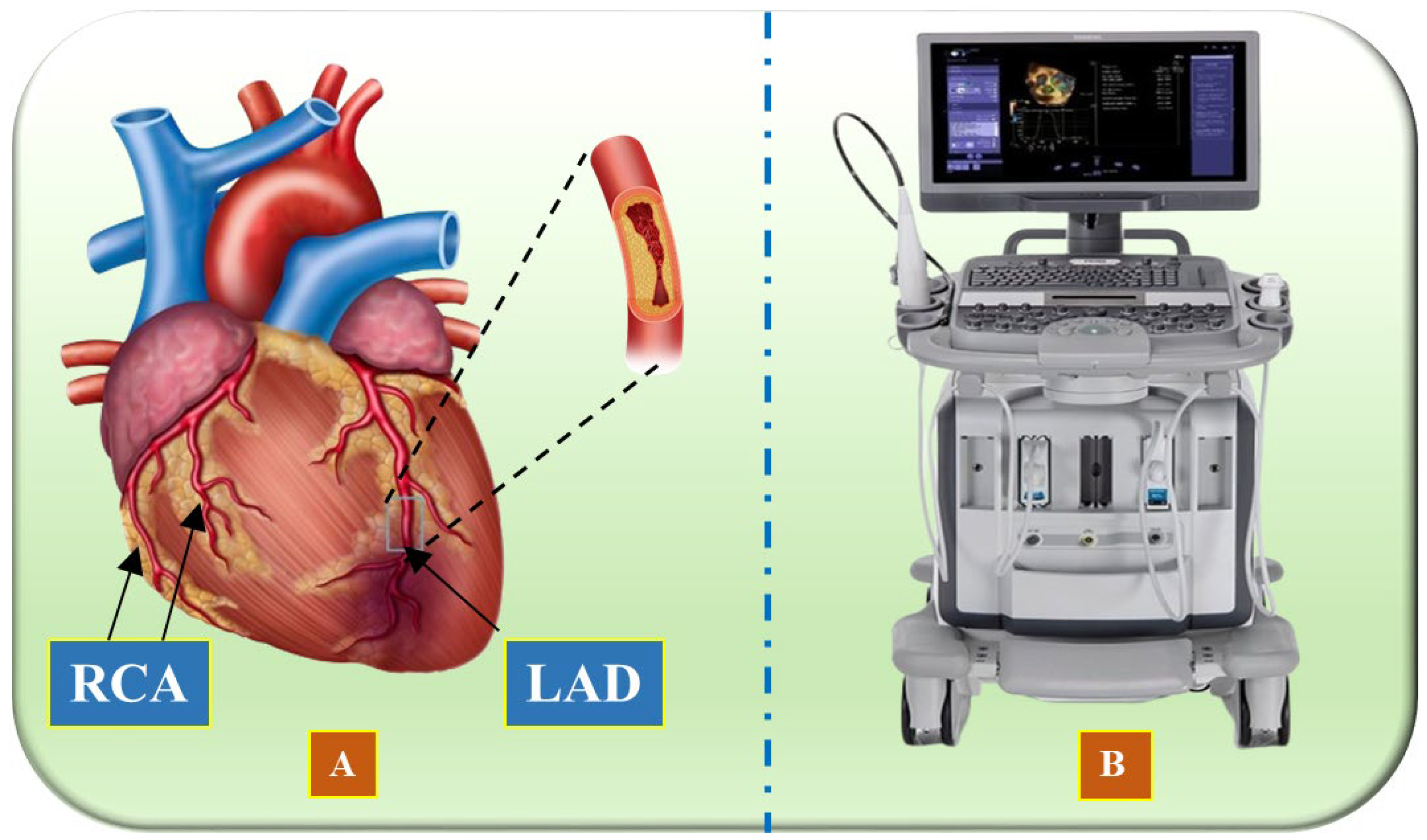
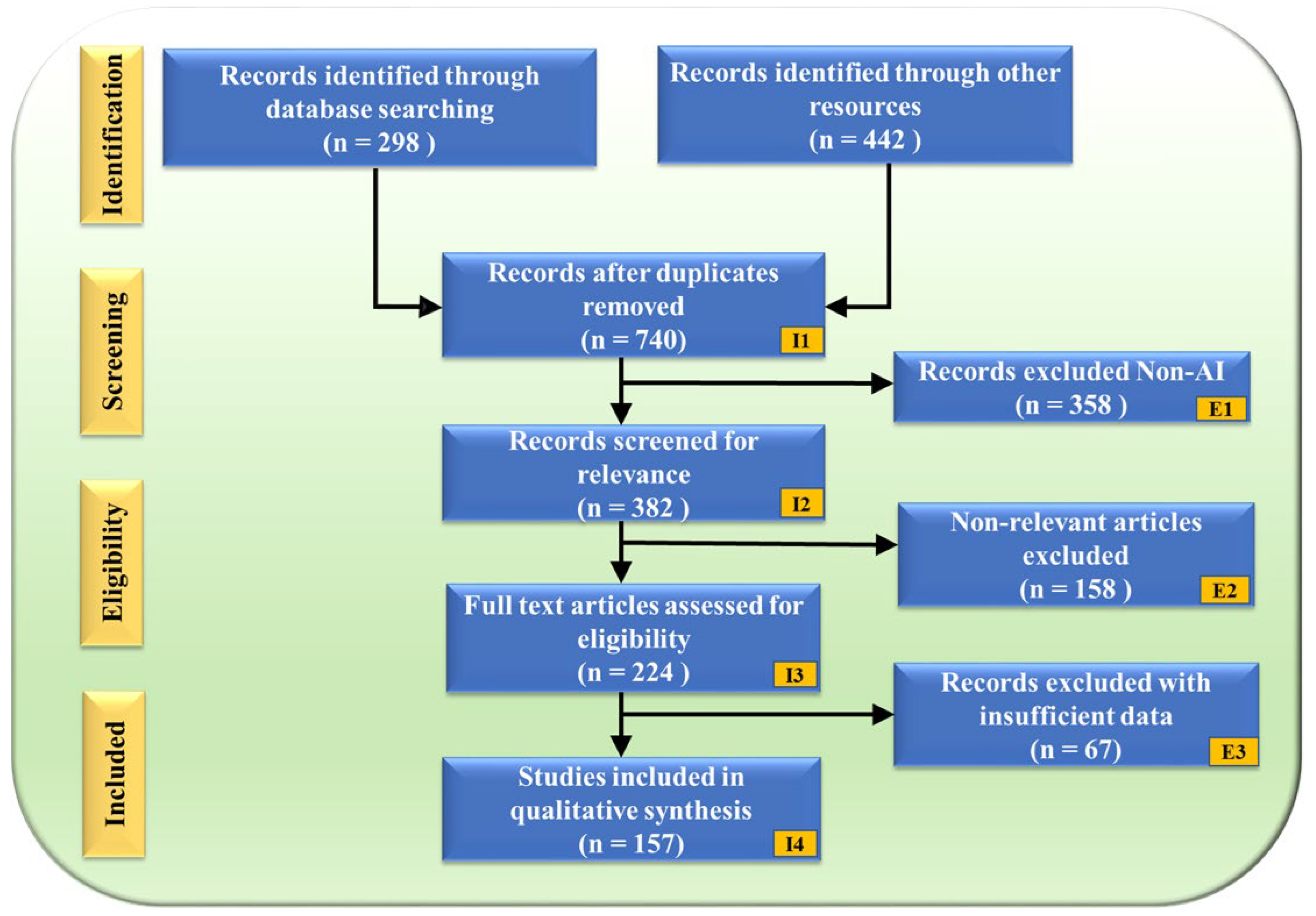
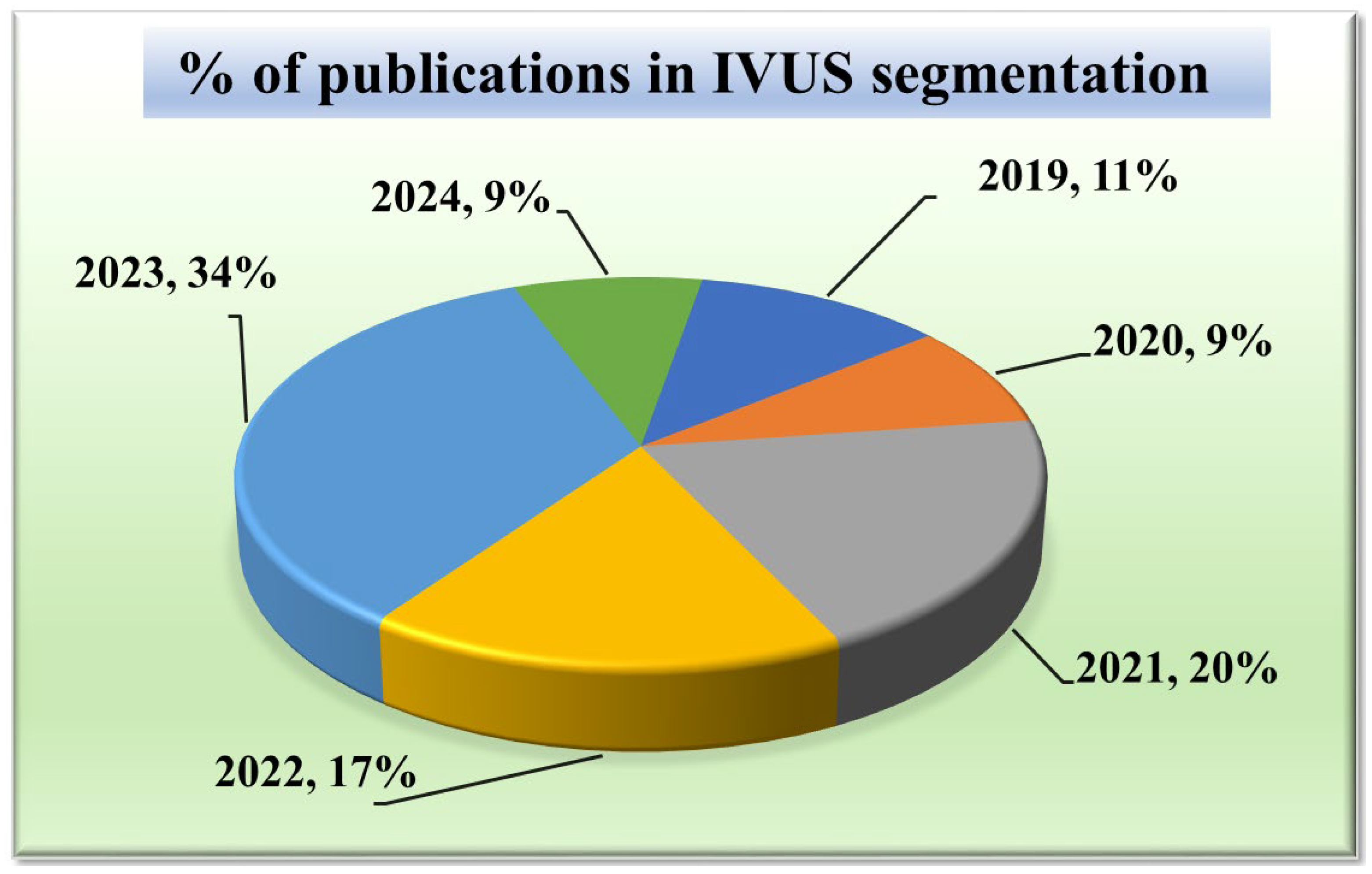
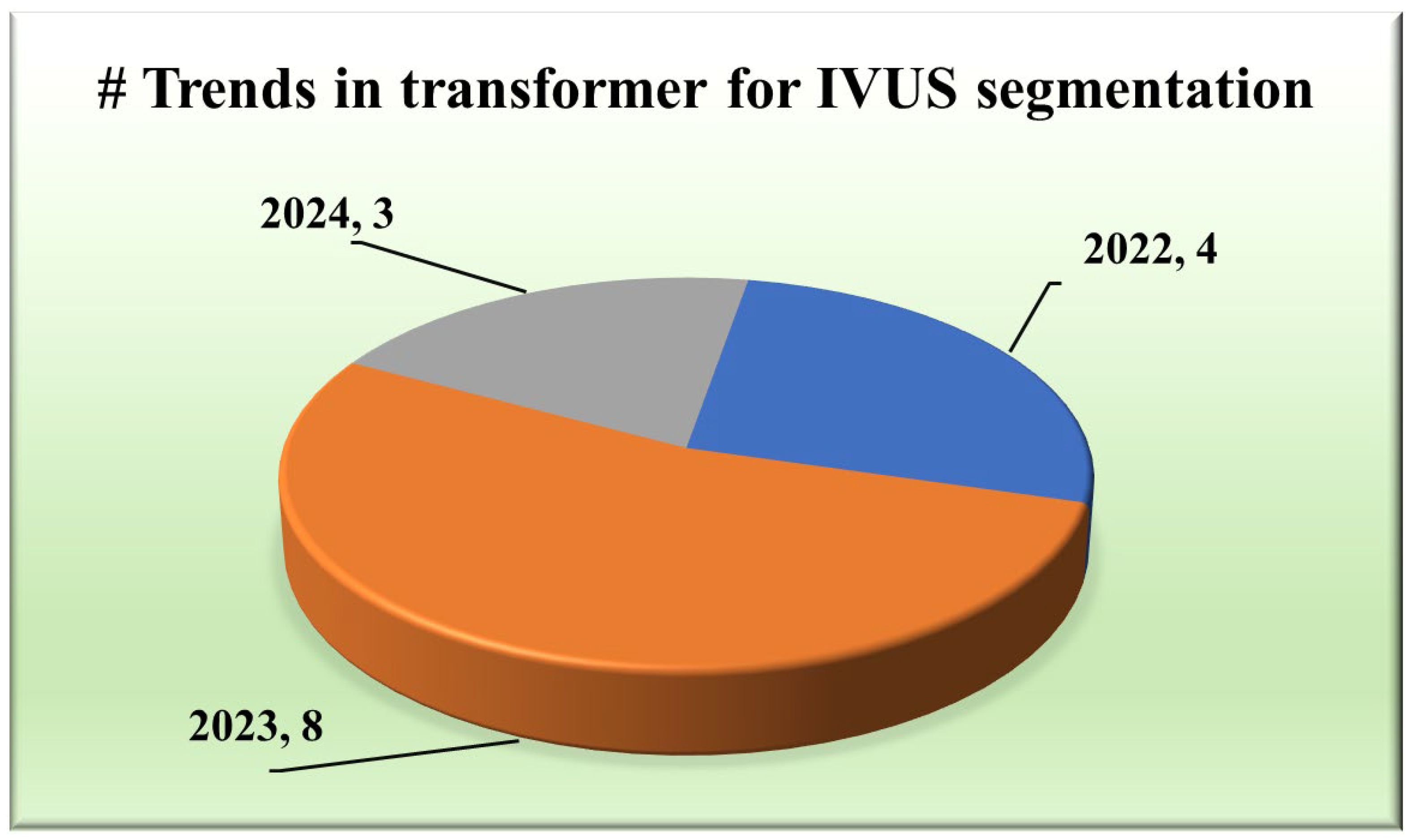

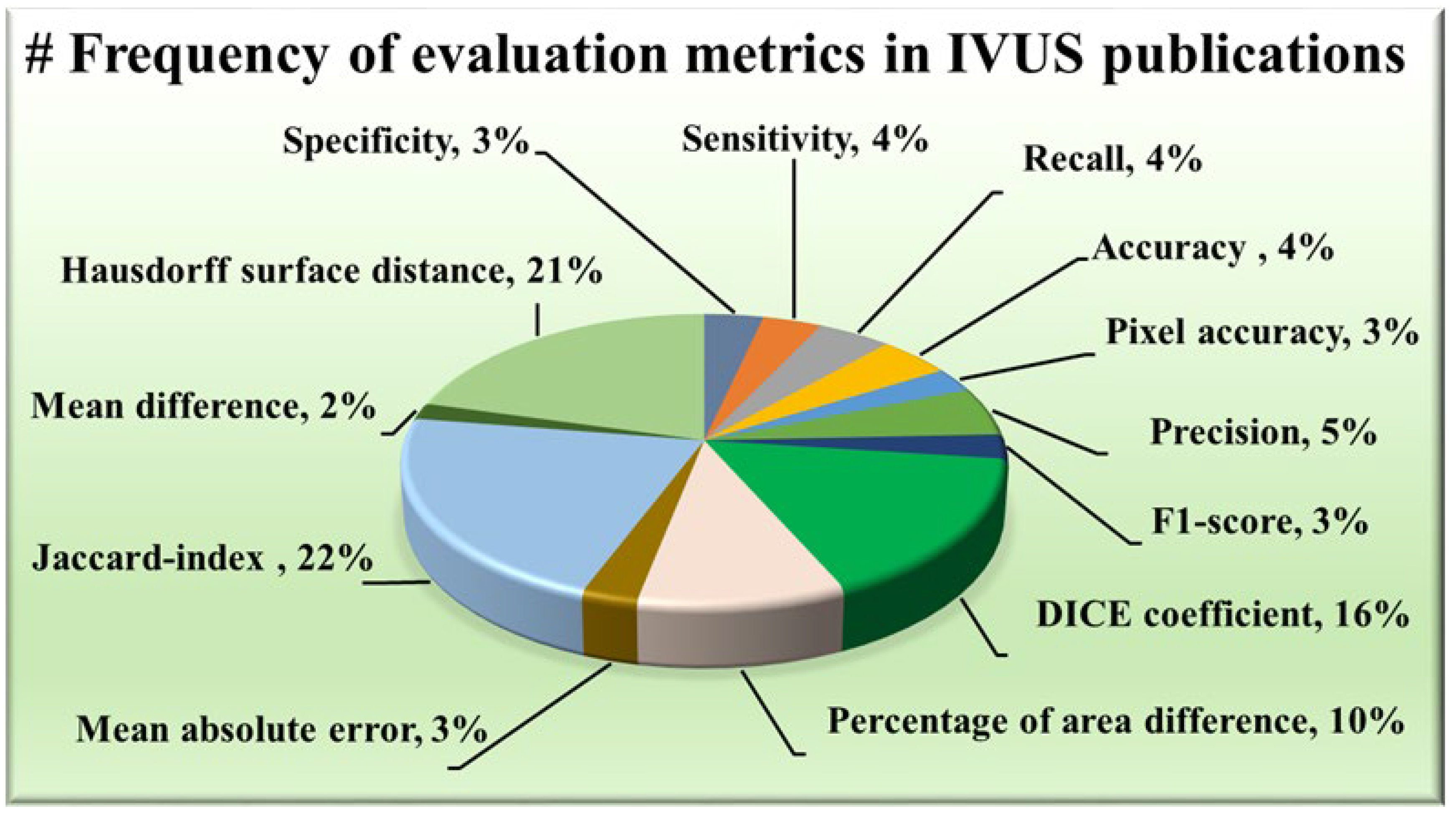


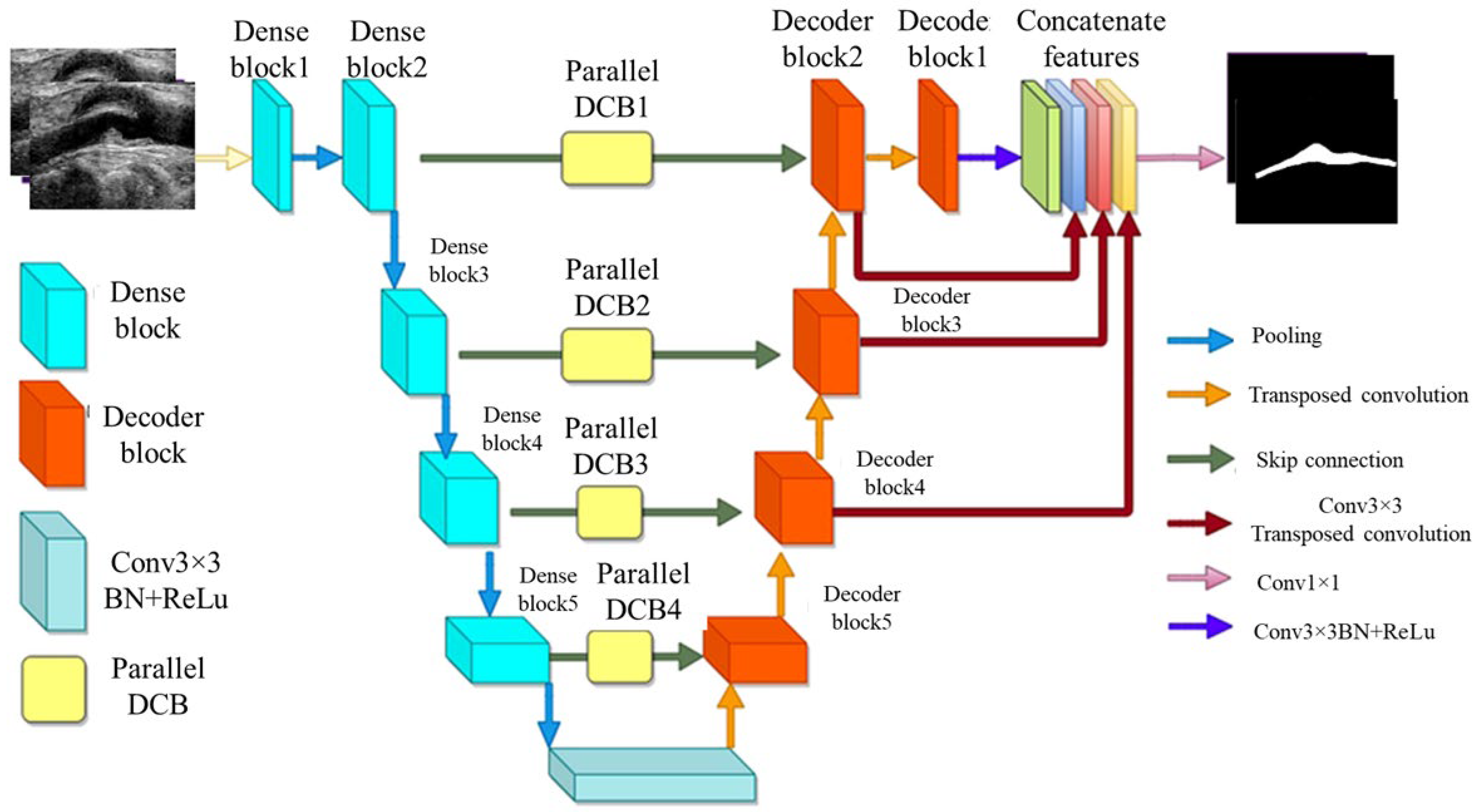
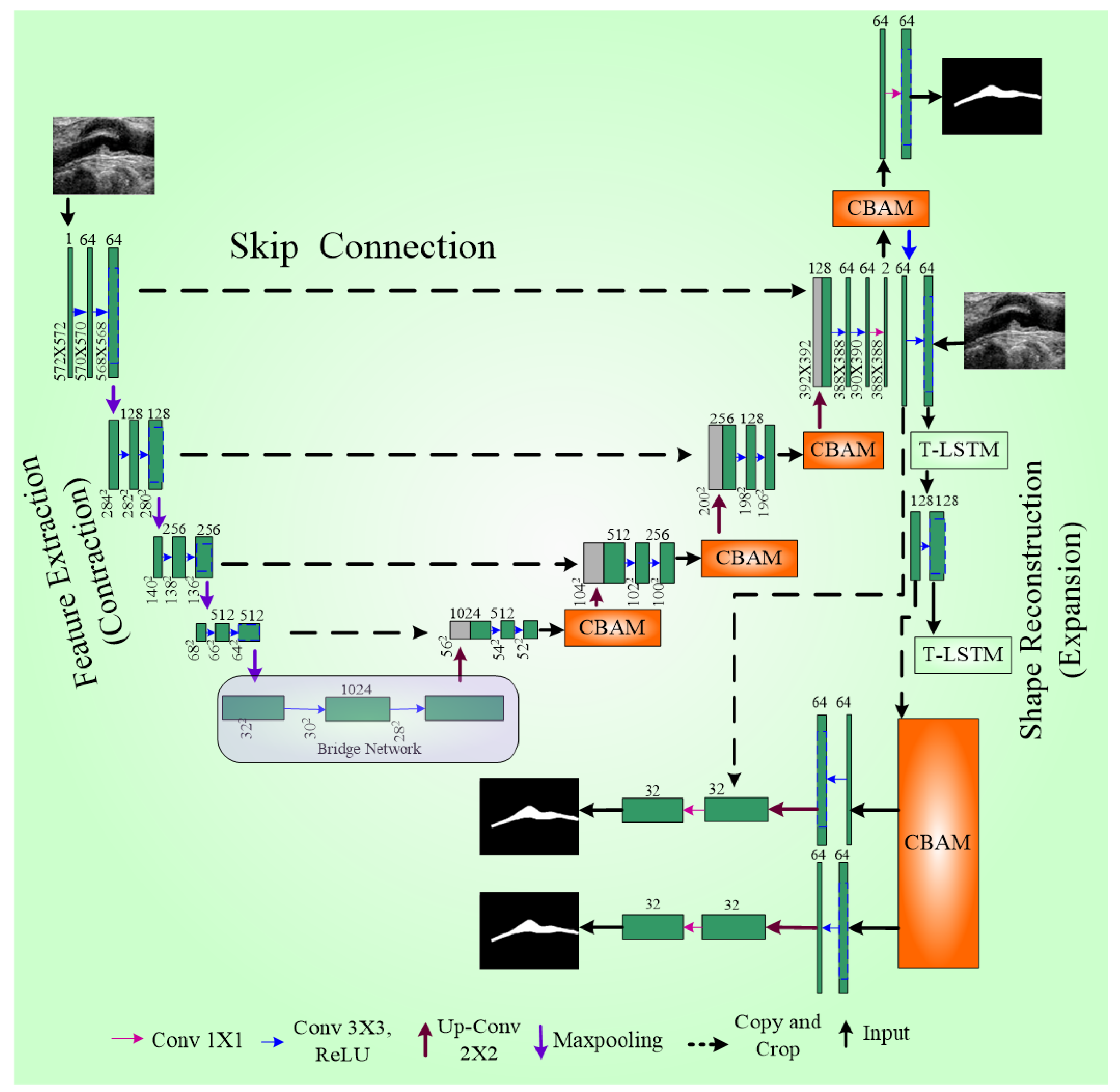
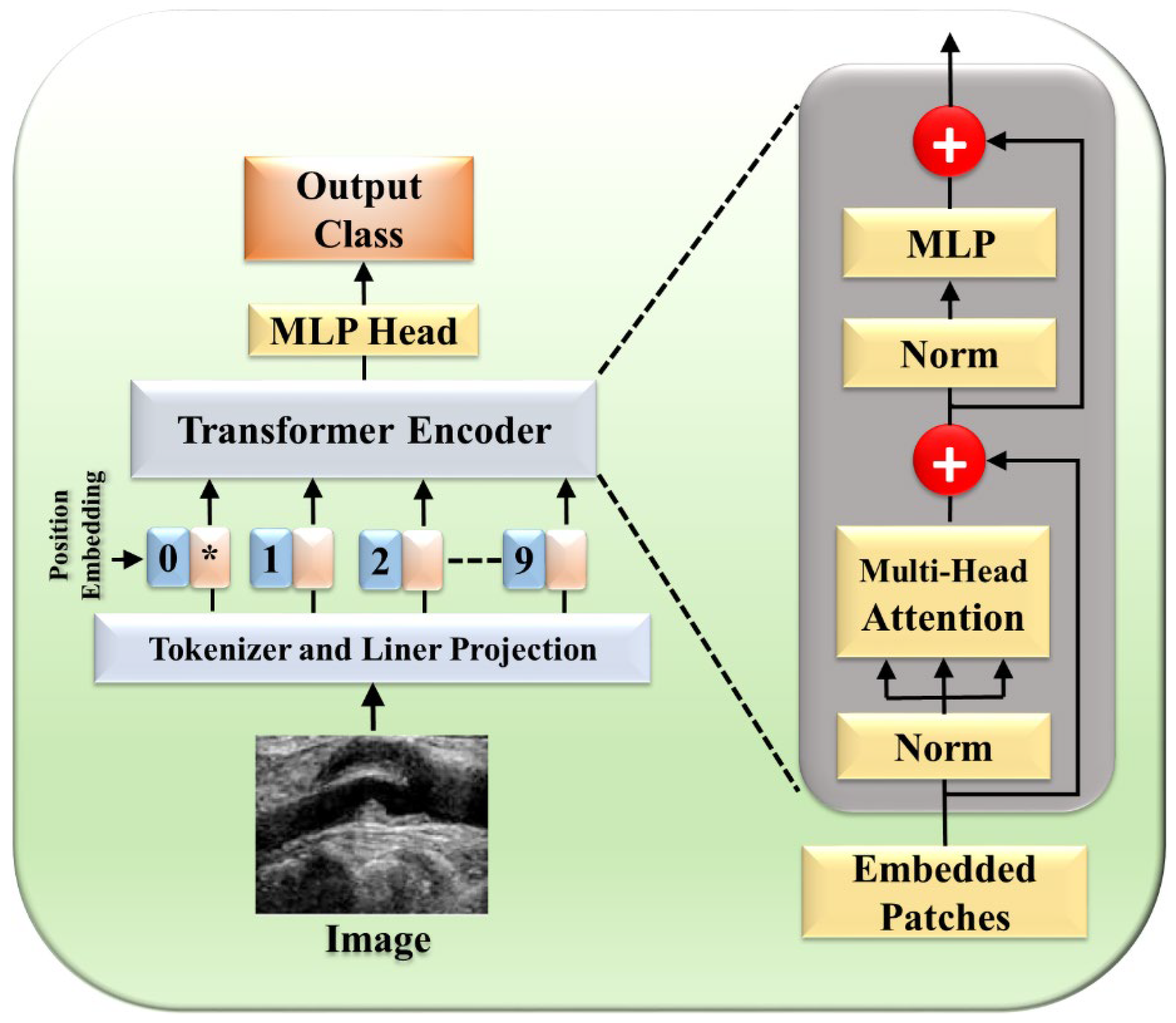
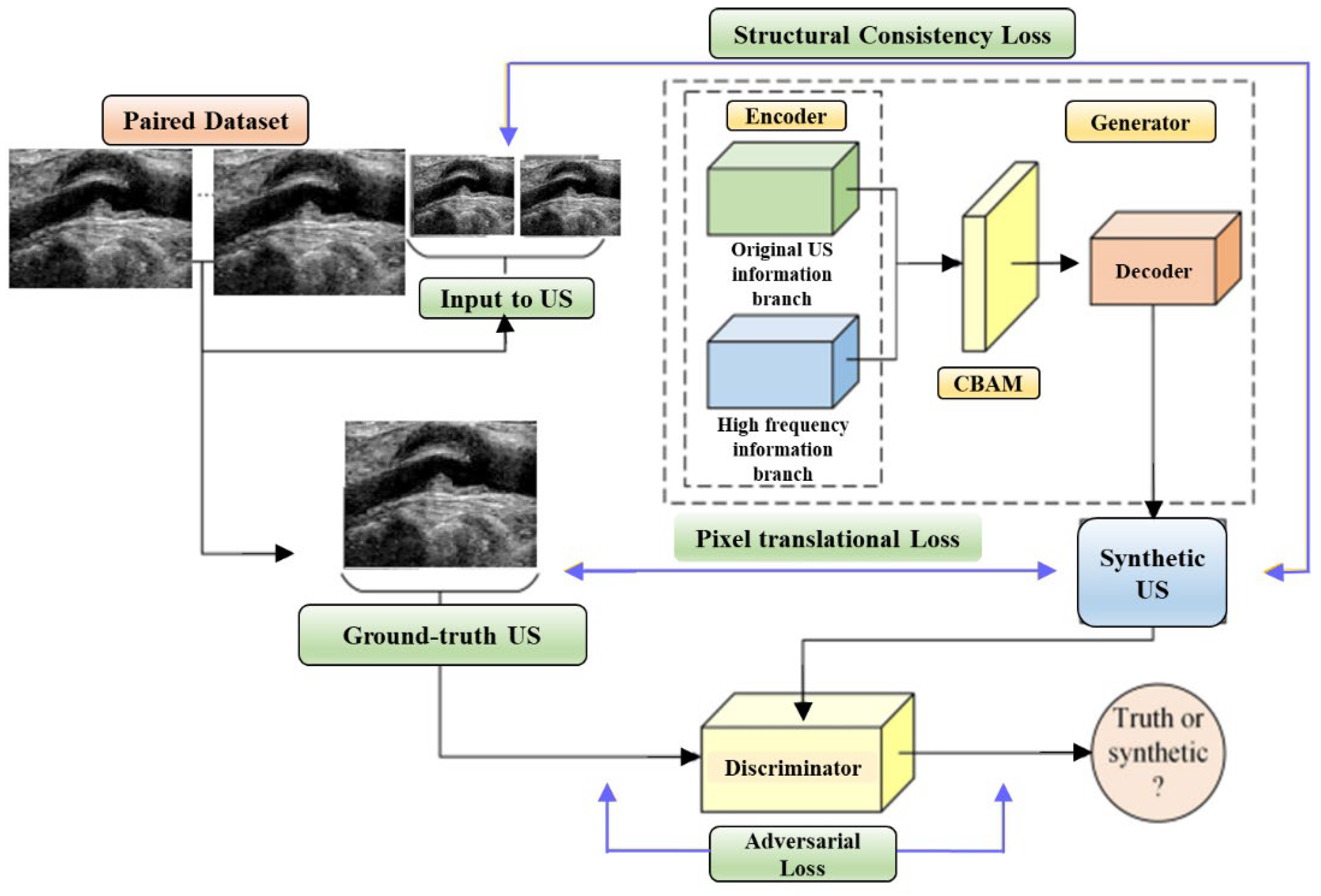
| Technique | Advantages | Disadvantages | Performance | Specific Application |
|---|---|---|---|---|
| Conventional Techniques | ||||
| Thresholding | Effective in removing catheter artifacts, sequential border estimation, ad hoc mechanism for discontinuous borders | May not perform well with complex and variable IVUS images | Jaccard measure: 0.84 ± 0.07 for Lumen, 0.82 ± 0.11 for MA border | Lumen-intima and media-adventitia (MA) borders segmentation |
| Active Contours | Fully automated, fast, and adaptive to the shape of the object | Sensitive to initialization, may get stuck in local minima | 96% reduction in analysis time compared to manual segmentation | Lumen and MA boundary segmentation |
| Machine Learning Techniques | ||||
| Markov Random Field | Incorporates spatial context, robust segmentation | Designing MRF and defining appropriate potential functions can be challenging, high computational cost | Not specified | Calcified plaque detection |
| Random Forest | Captures non-linear relationships, handles high-dimensional data well, provides feature importance insights | May overfit with noisy data, less interpretable than simpler models | Not specified | Identifying specific morphological structures within vessel walls |
| Deep Learning Techniques | ||||
| Non-UNet—Scale Mutualized Perception | Preserves complementary information from adjacent scales, distinguishes objects with similar local features | Complex architecture, may require large amounts of data for training | Not specified | Vessel boundary segmentation |
| Non-UNet—CSDN | Efficient segmentation, treats shallow and deep networks separately for high accuracy and efficiency | Complex architecture, may require large amounts of data for training | Not specified | Real-time segmentation |
| UNet and its variants (MFA-UNet) | Improves feature fusion and information retention, enables context retrieval from spatial-temporal perspectives | Complex architecture, may require large amounts of data for training | Optimized using Focal Tversky loss to address data imbalance | IVUS scan segmentation |
| UNet and its variants IVUS-UNet++ | More effectively captures fine-grained details of the foreground objects, uses feature pyramid network for multi-scale feature utilization | Complex architecture, may require large amounts of data for training | Best JM and HD for both lumen and MA border compared to UNet++ and IVUS-Net | Lumen and MA border segmentation |
| Attention and Transformer-based Methods | ||||
| POST-IVUS | Accurate segmentation of vessel walls in IVUS images, mimics cardiologists’ perceptual organization principle | Complex architecture, may require large amounts of data for training | Integrated into QCU-CMS1 software for automatic IVUS image segmentation | IVUS image segmentation |
| MSP-GAN | Preserves intravascular structures during domain adaptation, uses transformers for global pathology information preservation | Complex architecture, may require large amounts of data for training | Ensures local structures correspondence between source and translated images | IVUS domain adaptation |
| C0 | C1 | C2 | C3 | C4 | C5 | C6 | C7 | C8 | C9 |
|---|---|---|---|---|---|---|---|---|---|
| SN | Authors | NOF | Type of Data | Architecture Used | Attention | Transformer | #Patients/ #Images | CV | Results |
| R1 | Hammouche et al. [58] (2019) | 10 | Image | Helical active contour | ✗ | ✗ | 144/510 497/638 | K5 | Lumen detection accuracy of 99.42% and a minimal mean absolute error of 0.272 mm. |
| R2 | Giannoglou et al. [56] (2006) | 14 | Image | Active contour model | ✗ | ✗ | 97/970 | K5 | The study demonstrated a 96% reduction in analysis time compared to manual segmentation. |
| R3 | Wang et al. [96] (2021) | 17 | Image | ML | ✗ | ✗ | 379, 300 | K10 | Enhanced traditional snake algorithm, Otsu thresholding, morphological operations, and connected component labeling were incorporated |
| R4 | Vercio et al. [61] (2019) | 14 | Image | SVM with RF | ✓ | ✗ | 800 | - | High Dice similarity coefficient (DSC) of 0.91 for LI and 0.94 for MA. |
| R5 | Liu et al. [69] (2022) | 29 | Image | SMP | ✓ | ✓ | 378 | - | DSC of 0.96 for the lumen and 0.97 for the MA |
| R6 | Bargsten et al. [78] (2021) | 20 | Image | Capsule Network | ✓ | ✓ | - | - | Accuracy of 94.59% in lumen segmentation. |
| R7 | Proposed Study | 39 | Point | Transformers and Attention | ✓ | ✓ | 500 | K5 |
Disclaimer/Publisher’s Note: The statements, opinions and data contained in all publications are solely those of the individual author(s) and contributor(s) and not of MDPI and/or the editor(s). MDPI and/or the editor(s) disclaim responsibility for any injury to people or property resulting from any ideas, methods, instructions or products referred to in the content. |
© 2025 by the authors. Licensee MDPI, Basel, Switzerland. This article is an open access article distributed under the terms and conditions of the Creative Commons Attribution (CC BY) license (https://creativecommons.org/licenses/by/4.0/).
Share and Cite
Kumari, V.; Katiyar, A.; Bhagawati, M.; Maindarkar, M.; Gupta, S.; Paul, S.; Chhabra, T.; Boi, A.; Tiwari, E.; Rathore, V.; et al. Transformer and Attention-Based Architectures for Segmentation of Coronary Arterial Walls in Intravascular Ultrasound: A Narrative Review. Diagnostics 2025, 15, 848. https://doi.org/10.3390/diagnostics15070848
Kumari V, Katiyar A, Bhagawati M, Maindarkar M, Gupta S, Paul S, Chhabra T, Boi A, Tiwari E, Rathore V, et al. Transformer and Attention-Based Architectures for Segmentation of Coronary Arterial Walls in Intravascular Ultrasound: A Narrative Review. Diagnostics. 2025; 15(7):848. https://doi.org/10.3390/diagnostics15070848
Chicago/Turabian StyleKumari, Vandana, Alok Katiyar, Mrinalini Bhagawati, Mahesh Maindarkar, Siddharth Gupta, Sudip Paul, Tisha Chhabra, Alberto Boi, Ekta Tiwari, Vijay Rathore, and et al. 2025. "Transformer and Attention-Based Architectures for Segmentation of Coronary Arterial Walls in Intravascular Ultrasound: A Narrative Review" Diagnostics 15, no. 7: 848. https://doi.org/10.3390/diagnostics15070848
APA StyleKumari, V., Katiyar, A., Bhagawati, M., Maindarkar, M., Gupta, S., Paul, S., Chhabra, T., Boi, A., Tiwari, E., Rathore, V., Singh, I. M., Al-Maini, M., Anand, V., Saba, L., & Suri, J. S. (2025). Transformer and Attention-Based Architectures for Segmentation of Coronary Arterial Walls in Intravascular Ultrasound: A Narrative Review. Diagnostics, 15(7), 848. https://doi.org/10.3390/diagnostics15070848










